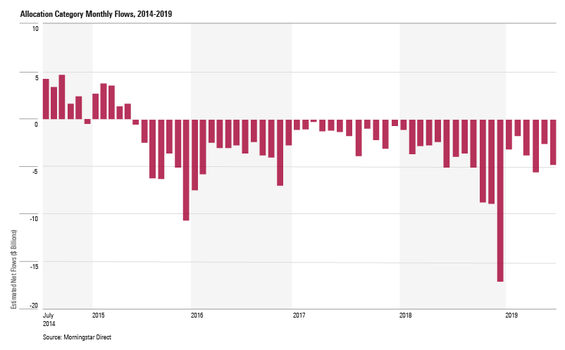Long-term fund flows enjoyed a solid second quarter and a robust first half of 2019. Long-term fund flows—open-end and exchange-traded funds—collected nearly $93 billion in the second quarter, a slight decrease from the first quarter’s $136 billion. In total, long-term fund flows collected $224 billion in the first half of the year, slightly ahead of 2018’s $219 billion. Money-market funds fared even better than long-term funds during the second quarter, taking in $111 billion, for a total of $142 billion over the first half.

We break down the factors contributing to these flows in the latest edition of the Morningstar Direct℠ Fund Flows Commentary. Below, explore some of our key findings.
Taxable- and municipal-bond funds continue to drive flows
The positive momentum continues for taxable- and municipal-bond funds, which collected about $95 billion and $23 billion during the second quarter, respectively.

Taxable-bond funds saw greater flows than all long-term funds combined as a result of net outflows from sector equity, international equity, allocation, and alternative funds in the second quarter. In the space, investors generally stuck to fairly conservative, core-oriented strategies: Intermediate-core bond funds drove $32 billion in second-quarter inflows, ultrashort-bond funds $12 million, and intermediate-government funds nearly $9 billion.
Municipal-bond funds, for their part, had their best first half in at least a decade, collecting nearly $51 billion.
Demand for more credit-oriented strategies was mixed:
- High-yield bonds saw a flat second quarter, after strong first-quarter inflows.
- Bank-loan funds saw a number of investor sales, experiencing more than $9 billion in outflows in the second quarter.
- Intermediate core-plus bond funds collected more than $19 billion.
- Multisector-bond funds added more than $8 billion. PIMCO Income ( PIMIX) dominated these flows with nearly $7 billion in the second quarter alone.
Passive market share hits 40%
Money continues to pour into passive funds, often at the expense of active strategies. In the second quarter, passive funds collected nearly $135 billion across all asset groups while active funds lost nearly $42 billion.

These results have become commonplace over the past five years, yet they’ve added up: Over the past 12 months, active funds have seen $341 billion in outflows while passive funds have taken in nearly $544 billion.
The flows into passive funds have impacted overall market share, which hit 40% by the end of the second quarter, up from 37.4% 12 months ago. Unless there’s a major shift in investor demand, passive-fund market share will eventually catch and perhaps surpass that of active funds.
Demand drying up for international equity funds
Second-quarter 2019 saw international-equity flows continue to decline, a turnaround from strong performance in recent years.

Though demand for equity funds overall has been weak for years, flows into international equity funds had been more resilient than their comparatively low returns (relative to U.S. equity funds) might suggest: Over the 10 years through June 2019, the typical foreign large-blend fund gained an annualized 6.4% versus 13.2% for the average large-blend fund. Yet, over the five years through March 2018, international equity funds collected $817 billion in flows versus just $239 billion for U.S. equity funds.
Yet, second-quarter 2019 was the fifth consecutive quarter of weak international-equity flows. The group had outflows of nearly $13 billion—its greatest outflows in at least a decade—despite the fact that the average foreign large-blend fund actually gained 3.0% during the quarter.
As with other asset groups, investor demand has narrowed significantly. For the year-to-date, only the diversified emerging-markets and foreign large-blend categories have received meaningful inflows: about $19 billion and nearly $13 billion, respectively. The rest of the group had nearly $31 billion in outflows.
Are allocation funds becoming obsolete?
Allocation funds are being shunned even more than international-equity offerings. The group lost about $13 billion in second-quarter 2019, for total outflows of $185 billion over its 16 consecutive quarters of negative outflows. However, thanks to robust capital markets, the group’s asset base still grew from $1.25 trillion to $1.34 trillion.

The likely reason for outflows from allocation funds, what used to be known as “balanced” funds, is the increasing popularity of target-date funds and other types of managed portfolios. The allocation funds group collectively may need to reinvent itself to remain relevant to investors.

